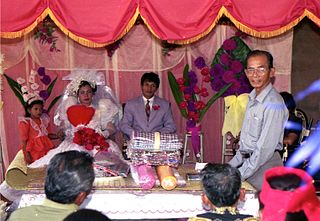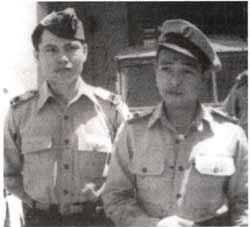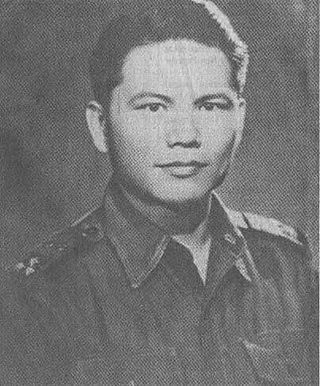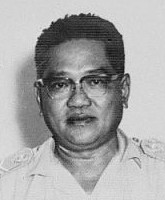
Central Sulawesi is a province of Indonesia located at the centre of the island of Sulawesi. The administrative capital and largest city is located in Palu. The province borders the provinces of Gorontalo to the east, Southeast Sulawesi, South Sulawesi, and West Sulawesi to the south, and sharing maritime borders with East Kalimantan to the west, North Maluku to the east, and Malaysia and the Philippines to the north.

Poso is the administrative capital of Poso Regency, Indonesia. It is the main port and transportation hub for the central-southern coast of Central Sulawesi. Its urban area consists of three districts, Poso Kota, North Poso Kota, and South Poso Kota. Poso lies in the middle of the province on the shore of the Gulf of Tomini, right in the central part of Sulawesi Island. With a total population of 47,477 in 2020, it is one of the biggest and oldest towns in the province.

The Minahasans or Minahassa are an indigenous ethnic group from the North Sulawesi province of Indonesia, formerly known as North Celebes. The Minahasa people sometimes refer to themselves as Manado people. Although the Minahasan pre-Christian creation myth entails some form of ethnic unification, before the nineteenth century the Minahasa region was in no way unified. Instead, a number of politically independent groups (walak) existed together, often in a permanent state of conflict.

Permesta was a rebel movement in Indonesia that was declared on 2 March 1957 by civil and military leaders in East Indonesia. Initially the center of the movement was in Makassar, which at that time was the capital of the province of Sulawesi. However, support for the movement in South Sulawesi gradually dissipated, forcing the headquarters to move to Manado in North Sulawesi.

The Indonesian Army is the land branch of the Indonesian National Armed Forces. It has an estimated strength of 300,400 active personnel. The history of the Indonesian Army has its roots in 1945 when the Tentara Keamanan Rakyat (TKR) "People's Security Army" first emerged as a paramilitary and police corps.

Tegal is a city in the northwest part of Central Java of Indonesia. It is situated on the north coast of the province of Central Java, about 175 km (109 mi) from Semarang, the capital of the province. It had a population of 239,599 at the 2010 Census and 273,825 at the 2020 Census; the official estimate as of mid-2023 was 262,781.
The Central Sulawesi Christian Church is the largest Christian church in Central Sulawesi, Indonesia. It belongs to the Reformed family of churches. The church was established in the early 1893 through the mission work of the Dutch Reformed Church and became an independent denomination in 1947 when Indonesia declared its independence from the Netherlands and ordered all Dutch nationals to go home. November 1993, there was in Tentena a celebration feast for 100 years Christianity.

Poso Regency is a regency of Central Sulawesi Province of Indonesia. It covers an area of 7,438.55 km2, and had a population of 209,228 at the 2010 Census and 244,875 at the 2020 Census; the official estimate as at mid 2023 was 251,654. The principal town lies at Poso.
A market in the center of Tentena, Central Sulawesi, Indonesia was bombed on 28 May 2005. Two improvised explosive devices, set to explode 15 minutes apart, detonated during the morning, killing 22 and wounding at least 40 more. The fatalities included a Christian clergyman and a 3-year-old boy. Several Islamic militants were later charged and sentenced to jail terms in 2007 and 2010 for their roles in organizing the bombing, among other sectarian attacks in the Poso region.

Abdul Kahar Muzakkar was the leader of an Islamic movement in South Sulawesi from 1950 till his death in 1965. He led his group of men in a guerrilla warfare against the Indonesian central government, and was finally killed by the army in the jungle. He was also the leader of the South Sulawesi branch of the Darul Islam movement.
A series of terrorist attacks targeting public transport occurred in Poso, Central Sulawesi, Indonesia, between 5 June and 8 August 2002. In total 7 people were killed and 26 wounded, including an Italian tourist. The first attack occurred on 5 June 2002, when a bomb detonated in an Antariksa-owned public bus servicing the Palu, Poso and Tentena routes. Four passengers were killed instantly and 17 more were wounded, one of who would succumb to his injuries two weeks later. On 13 July 2002 the second attack occurred on the trans-Sulawesi highway when the bus driver found a bag lying on the road and asked his conductor to retrieve it, triggering the device: an 18-year-old bystander was killed and at least 4 others severely wounded in the blast. In the third attack, on 8 August 2002, an Italian tourist was killed and at least 4 Indonesians injured when unknown assailants fired automatic weapons into another bus.

The Pamona people is an ethnic group of Indonesia. They inhabit almost the entire Poso Regency, parts of Tojo Una-Una Regency and parts of North Morowali Regency, Central Sulawesi; in fact there are some even in East Luwu Regency of South Sulawesi, whereas a small remainder lives in other parts of Indonesia. The ancestors of the Pamona people originally came from the land of Salu Moge because they were once from the mountains which is far from the central governance thus they were brought down by Macoa Bawalipu of Wotu, East Luwu Regency to be nearer to the central governance, which is the surrounding region of Mangkutana. But it was until a revolt by the DI/TII rebellion broke out that they spread to Central Sulawesi and to other regions. If there are Pamona people in certain regions, then it is common that a Rukun Poso is formed there, which serves as a means of a group of people from a common ethnic background to engage in various activities within the region. Almost all of the Pamona people practices Christianity. Christianity came into the region at the end of the 19 century and until today it is widely accepted as the religion of the people. Today, all churches of common denomination are grouped under the Central Sulawesi Christian Church headquartered in Tentena, Poso Regency, Central Sulawesi, Indonesia. A large part of the common folk uses Pamona and Indonesian language that is mixed with the local slang. The Pamona people are usually farmers, government officials, pastors, entrepreneurs and so on.

Adolf Gustaaf Lembong was an Indonesian military officer involved in guerrilla warfare against Japan in the Philippines during World War II and subsequently in the struggle for Indonesian independence. He was killed during the APRA coup d'état in Bandung.

Jacob Frederick Warouw, also known as Joop Warouw, was a military officer involved in the Indonesian National Revolution. After the revolution, his appointments include Commander of VII/East Indonesia Military Territory and Military Attaché in Beijing. He was subsequently involved in the Permesta movement that sought greater regional autonomy from the central government in Java. He was killed by a fractious unit toward the end of the movement.

Operation Madago Raya, previously known as Operation Tinombala, is a joint police–military operation conducted by the Indonesian National Police and the Indonesian Armed Forces to capture and/or eliminate members of Mujahidin Indonesia Timur (MIT), an Indonesian terrorist group which supports ISIL and was commanded by Santoso. In 2016, the Indonesian military and police succeeded in killing Santoso, but the then Chief of the National Police Tito Karnavian continued the operation to ensure the region's safety from the remaining members of the group. Central Sulawesi governor Longki Djanggola praised the operation for its relatively humane methods, since several leaders of the group were successfully captured alive. Only 19 militants were, however, captured alive, while more than 40 were killed.

Alimuddin Daeng Matiro was the second regent of Poso Regency, Central Sulawesi, Indonesia; who ruled from 1954 to 1956. As well as the first regent of Poso, Abdul Latif Daeng Masikki, he also came from the military.

The Poso riots, also known as Poso communal conflict, is a name given to a series of riots that occurred in Poso, Central Sulawesi, Indonesia. This incident involved a group of Muslims and Christians in the region and was divided into three stages. The first Poso riot took place from December 25 to 29, 1998, continued from April 17 to 21, 2000, and finally from May 16 to June 15, 2000.

Frits Johanes Tumbelaka, also known as Broer Tumbelaka, served in the Indonesian military, rising to the rank of lieutenant colonel. He also served in the government as governor of North and Central Sulawesi and, after the province was split into North Sulawesi and Central Sulawesi, he served as the first governor of North Sulawesi. He played an important role in finding a peaceful solution to the conflict between the Indonesian government and the Permesta movement.

Korem 132/Tadulako or Military Area Command 132nd/Tadulako is a Military Area Command (Korem) under Kodam XIII/Merdeka. Its garrison located on city of Palu, Central Sulawesi. It consists of five military district commands (Kodim) and one light infantry battalion attached located in Poso. The formation is involved in various insurgencies against Islamic extremist insurgency in the region, most recently against East Indonesia Mujahideen in Poso Regency.

















